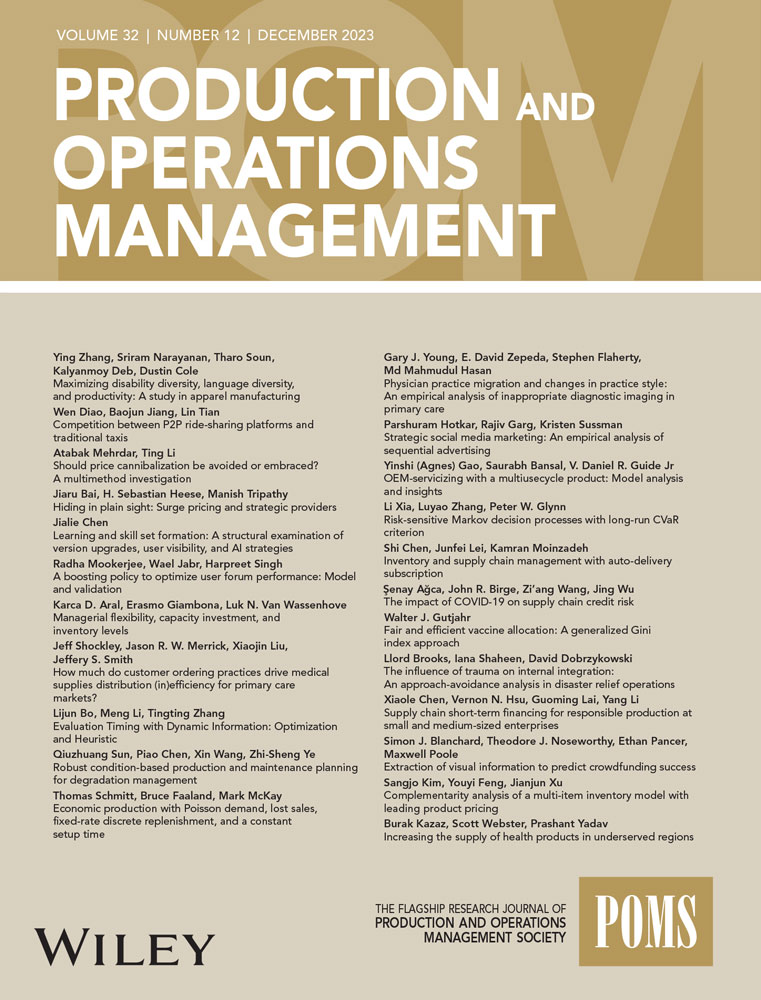设计航运政策与充值选项,以符合免费送货资格
IF 4.8
3区 管理学
Q1 ENGINEERING, MANUFACTURING
引用次数: 0
摘要
摘要:在蓬勃发展的在线杂货市场和电子杂货行业中广泛使用的或有免运费(CFS)政策的激励下,我们研究了在线杂货商的最佳CFS和定价决策。根据中心的政策,顾客订购的货品超过某一临界值,便可享受免运费服务;否则,他们将对低于这个门槛的订单收取固定费用。我们采用基于效用的模型来捕捉消费者在CFS政策下购买额外物品以获得免运费资格的行为,并分析其对政策结构和消费者剩余的影响。我们对电子杂货商的最优定价和CFS政策进行了表征,发现消费者异质性和需求分布导致了不同形式的最优运输政策。当消费者异质性足够大时,最优策略会诱导一些消费者充值,并可能允许其他一些消费者免费送货。在这种情况下,电子杂货商可以收取高利润率。否则,充值选项是不必要的,而统一费率的运费政策是最佳的。此外,尽管最优政策永远不会在消费者理性的情况下诱使所有消费者进行充值,但当消费者将某些心理负效用与运费联系起来时,就有可能做到这一点。令人惊讶的是,在后一种情况下,最优政策下的总消费者剩余可能会增加。我们进一步建立了电子杂货商和线下渠道之间的Stackelberg博弈模型,发现电子杂货商的内部运输成本和消费者在线下购物的不便成本之间的差异是市场细分的主要驱动因素。最后,我们发现,当消费者的订单规模和频率独立时,除了联合优化的CFS和定价政策外,基于订阅的免运费计划不能提高利润。我们的研究结果有助于在线杂货商在消费者充值行为的影响下做出运营和营销决策。本文章由计算机程序翻译,如有差异,请以英文原文为准。
Designing shipping policies with top‐up options to qualify for free delivery
Abstract Motivated by the booming online grocery market and the extensive use of contingent free‐shipping (CFS) policies in the e‐grocery industry, we investigate the optimal CFS and pricing decisions for online grocers. Under a CFS policy, consumers enjoy free shipping for orders exceeding a certain threshold value; otherwise, they are charged a flat fee for orders below this threshold. We adopt a utility‐based model to capture consumers' behavior of purchasing additional items to qualify for free shipping under a CFS policy and analyze its impact on policy structure and consumer surplus. We characterize the e‐grocer's optimal pricing and CFS policy and find that consumer heterogeneity and demand distribution lead to different forms of the optimal shipping policy. When consumer heterogeneity is large enough, the optimal policy induces some consumers to top up and may allow some others to ship for free. In this case, the e‐grocer can charge a high‐profit margin. Otherwise, a top‐up option is unnecessary, and a flat‐rate shipping fee policy is optimal. Moreover, while the optimal policy never induces all consumers to top up when they are rational, it is possible to do so when consumers associate some psychological disutility with the shipping fee. Surprisingly, the total consumer surplus under the optimal policy may increase in the latter case. We further model a Stackelberg game between an e‐grocer and an offline channel and find that the difference between the e‐grocer's internal shipping cost and consumers' inconvenience cost of shopping offline is a main driver for market segmentation. Lastly, we show that a subscription‐based free‐shipping program, in addition to the jointly optimized CFS and pricing policy, cannot improve profits when consumers' order size and frequency are independent. Our findings help online grocers make operational and marketing decisions under the impact of consumers' top‐up behavior.
求助全文
通过发布文献求助,成功后即可免费获取论文全文。
去求助
来源期刊

Production and Operations Management
管理科学-工程:制造
CiteScore
7.50
自引率
16.00%
发文量
278
审稿时长
24 months
期刊介绍:
The mission of Production and Operations Management is to serve as the flagship research journal in operations management in manufacturing and services. The journal publishes scientific research into the problems, interest, and concerns of managers who manage product and process design, operations, and supply chains. It covers all topics in product and process design, operations, and supply chain management and welcomes papers using any research paradigm.
 求助内容:
求助内容: 应助结果提醒方式:
应助结果提醒方式:


